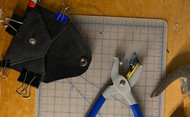With limited workspace and a few leathercraft tools you can teach yourself the skills to create and complete your first leatherwork project. The most basic projects require a stable knife-resistant work surface, a few sharp leatherwork crafting knives, a straight edge, and leather. However, many early projects will involve sewing, gluing, hole-punching and metal elements such as snaps and rivets which require special equipment. Luckily none of these tools are costly, heavy, or take up much space and they are all very simple to use. A good first project, such as this DIY-chic card case will allow you to practice basic leatherwork skills while you experiment with the tools and material. To make the card case you will need the following:

Japanese Garden Tools Vs. American: What’s the Difference?
You may have seen Japanese gardening tools popping up more in stores and online. Sure, they&rs… Read More


